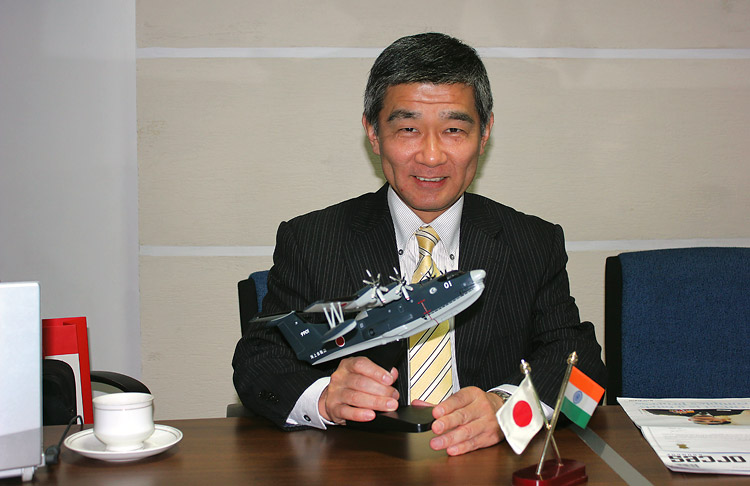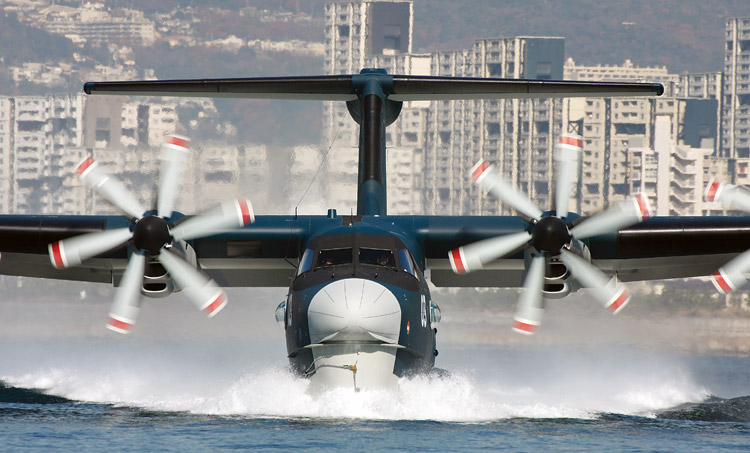- Prime Minister Narendra Modi inaugurates Aero India 2023 in Bengaluru; Releases Commemorative Stamp
- Defence Secretary meets delegations from Saudi Arabia, USA and Oman on the sidelines of Aero India 2023
- Foreign Ministers of 32 countries to attend Aero India 2023
- Embraer showcases the C-390 Millennium at Aero India 2023
‘The US-2 is a tried and tested amphibious aircraft’
Kanji Ishimaru, Managing Director, ShinMaywa Industries India Pvt Ltd

SP’s ShowNews (SP’s): ShinMaywa is a recent entrant into the Indian Aerospace segment. Can you please enunciate your company's profile, past achievements and business development?
Kanji Ishimaru (Ishimaru): About 90 years ago, ShinMaywa Industries began its business operations as the Kawanishi Machinery Company when the Kawanishi Type II seaplane was manufactured for the then Imperial Japanese Navy. It was a leading aircraft manufacturer for many decades. After World War II, the company utilised its expertise in the aerospace segment to diversify into special purpose trucks and industrial machinery for many customers. Later, the company was renamed ShinMaywa Industries Ltd (ShinMaywa meaning new, bright and harmony) and expanded its business to once again start manufacturing seaplanes. Since then our product range has expanded to include passenger boarding bridges, environmental systems, pumps, direct drive motors, automated car parking systems, etc. We now have customer network in over 100 countries with overseas manufacturing plants in five countries. ShinMaywa has recorded sales of about $1.3 billion last year. ShinMaywa is committed to substantial contribution in the social sector and upliftment of weaker sections of the society. Our corporate policies attach great importance and priority to safety and quality standards, work ethics, efficient production, delivery schedules and costs in all its operations. The company has supplied about 50 seaplanes to the Japanese Maritime Self Defence Force (JMSDF). Its latest product is the US-2, which is in operational service with the JMSDF since 2007.
SP’s: What are the characteristics and operational capabilities of Seaplane US-2 which may be of relevance to the Indian Navy's mission assignment, and could this platform be of utility to the Indian Army and the Indian Air Force?
Ishimaru: The US-2 is a tried and tested amphibious aircraft which has served the JMSDF extremely well for over five years. Important characteristics of this aircraft include its capability of landing and take-off in high seas in rough sea state condition (up to sea state 5). In addition, to the central role of long-range search and rescue (SAR) and exclusive economic zone (EEZ) surveillance, this aircraft can be highly useful in conducting anti-piracy missions, long-range fleet support, remote island support and constabulary operations like fishery protection, prevention of toxic dumping at sea, illegal human migration and smuggling of weapons and drugs. For most of the stated missions, the Indian Navy is currently deploying its sophisticated and high technology warships, incurring heavy costs on prolonged deployments. Additionally, we also believe that the unique capabilities of the US-2 amphibian aircraft can be gainfully utilised by the Indian Army as also the Indian Air Force in high-altitude areas, river/lake operations and for transportation and medical evacuation of people and stores from remote areas and forward locations. The US-2 can also carry out complex HAND and disaster management operations. As you can see, US-2 is a very versatile aircraft and is capable of undertaking multifarious and highly useful roles. At the same time it provides the users with low-cost solutions to the low levels of security, surveillance, rescue and constabulary operations. Accordingly, we have offered the same US-2 to the Indian Navy.
SP’s: What are the unique technology features inducted which make US-2 amphibian aircraft a versatile platform to operate at sea on multifarious missions?
Ishimaru: The US-2 amphibian aircraft with its matchless short take-off and landing capabilities, its unrivalled sea keeping abilities and outstanding endurance is ideally suited for all benign and constabulary missions of a modern navy. The short take-off and landing (STOL) technology is based on boundary layer control (BLC) which allows ultra-low speed operations and introduction of spray suppressor technology to enable rough sea operations in waves of up to three-metre high, which no other aircraft has achieved, so far. It also requires the least take-off and landing distance whether on land or sea, the longest range, the highest payload and is the only aircraft in its class which is proven, in-service and certified/ruggedised for military specifications. Its radar system combines both weather and surface surveillance and it has the most modern avionics, aero engines and a rugged aerostructure. Most of all, it is high quality ahead in the art product.

SP’s: For how long have been the footprints of ShinMaywa in India and what is your vision on business development in this country?
Ishimaru: ShinMaywa began its business operations in India almost 20 years ago. We already are a major supplier of passenger boarding bridges and wire terminating machines to Indian customers. Our present focus is to introduce the US-2 in the Indian Navy. All our products are of unmatched quality and use very powerful modern technologies that meet the aspirations of modern customers for best in class products. However, we wish to expand our operations in a calibrated manner which ideally suits the Indian business environment and will best contribute to the needs of the Indian armed forces as well as other customers in India.
SP’s: What is your long-term perspective on expanding your product range and business relationship in India?
Ishimaru: We have responded to the Indian Navy's request for information (RFI) for the amphibious aircraft. In addition, we also have regular queries for our other engineering products and environmental systems. The long-term aim is not to just establish a typical "buyer-seller" relationship by selling state-of-the-art products, but we also intend to manufacture locally the service and maintenance facilities of some of our products in India, involve the Indian MSME in our supply chain, work with Indian design and engineering companies for new products and perhaps also engage with Indian academia. That would help in bringing new technology and capability for the Indian industries. We are here in India to establish a long-term relationship and we plan to grow in a calibrated and systematic manner.





